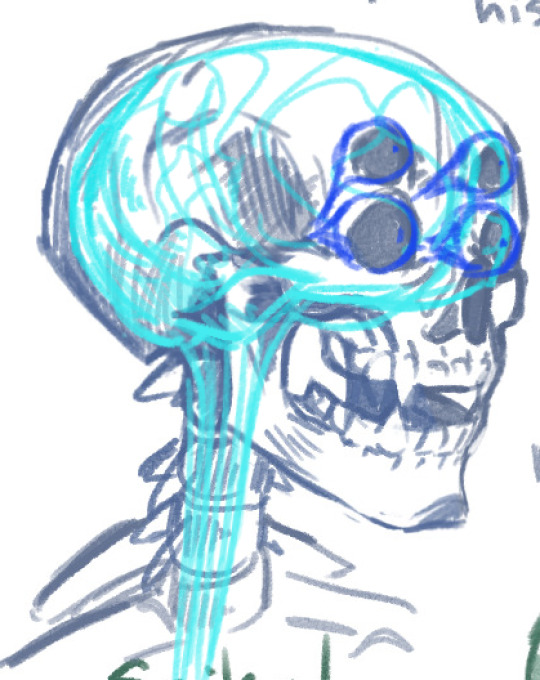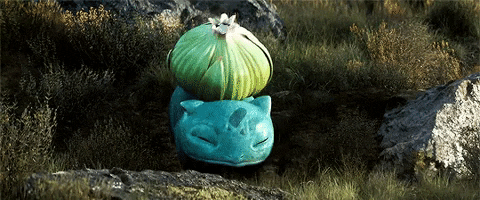#This also implies that there are variants that are malformed to the point of genetic dysfunction. Which there are- and plenty.
Text

I've been thinking about their anatomy again and decided to try drawing skeletons from memory ehehe
Nate and Amon! Lol I need to work harder on my skeletal anatomy but this certainly gives an idea on how their skellies look! Nate's base form has four eyesockets. Freaky!
While Amon is relatively straightforward bone-wise, I got some yucky nervous system sketch below the cut for Nate:

Nathaniel, like most psychic variants, also has a big large brain that is more susceptible to complications from traumatic injury. And four eyeballs that are linked in pairs to each hemisphere of the brain. Shifters tend to have a lot more development in their parietal lobe, which deals with body input, body image, movement, spatial awareness, and a whole lot of other functions.
The spinal cord is also thicker in most shifters thanks to the additional influx of information that is processed. Both sides of his variation give him additional nervous input, allowing for him to be the extrasensory blue quadfocal elf man we know and love!
#devarambles#nathanieltag#amontag#This also implies that there are variants that are malformed to the point of genetic dysfunction. Which there are- and plenty.#While humanoid anatomy tends to seek out 'evolution' in the form of DNA replication and replacement#Many variants that are forced to receive different splices or abilities can get into messy complications.#Maybe DON'T give the pyrokinetic variant a splice that will make her vulnerable to burns. Don't make the alloy shifter allergic to metal et#i just really love anatomy and i hope you can bear with it even though it is super unrealistic ahah#ARK_SYSTEMA
21 notes
·
View notes
Text
So I've been thinking about Pokémon. I do that a lot. My inner Zoobooks kid demands it. But recently I was rewatching some of the old anime for Reasons and realized the games exist in universe as some sorta goofy edutainment simulator. Made me start thinking about 'what if the games oversimplify pokémon biology like Odell's Lake and the like oversimplify real world biology' and uh. With all due gratitude to @bogleech (who does reviews for pokemon designs that I adore) and the nature YouTubers I consume daily.
I would like to yell at you about Bulbasaur a little, Tumblr.

So imma get real nerdy real fast here. I love me some speculative extrapolation.
First off let's look at one of the official game designs real quick.

Okay, so, a sauroid design--I know that seems obvious from the name but hold on here, I have a point.
So here we have a large quadrapedal exotherm with obvious green coloration. Not just dull green, bright green. Given the species line is famous for learning Solar Beam, an attack that necessitates gathering sunlight and transforming it into an attack, we can probably be safe in assuming a lot of that green is chlorophyll, making this a rare non-marine vertebrate capable of using chlorophyll to produce energy for itself. And, occasionally, to gather enough energy to tell predators to step off.
The bulb and the... well, the 'saur, appear to be a package deal, but the bulb is not only distinct from the main body, it may be the primary source of its Grass typing, with the Poison typing belonging to the sauroid hefting that bulb around. That kinda distinction leads me to believe the bulb doesn't naturally grow on the Bulbasaur, and may be the result of a parent or sufficiently trained human implanting the seed for the bulb in its back. Meaning the body can have a set of two genetic parents while the bulb can have genetics coming from any flowering plants of that species in whatever area they're born to.
I wonder if the sauroids without bulbs are capable of surviving on their own or if this was an adaptation out of necessity. Like how megafauna in our actual world died off when the ecosystem could no longer support their energy needs. Are the bulbs needed to get to their size, leaving unaided young smaller to survive without the energy boost? If they were smaller and had weaker skin without the Grass-type boosting, I can see them being analogous to venomous toads. If they're needed for survival, it implies strong social ties, possibly entire colonies or troops of their evolutionary line, in order to provide new 'Saurs with their bulb seeds.
Also, if the two parts of the Bulbasaur are distinct, that implies the bulb is supplementing a diet that was already supporting the animal body. Given the name of the final evolution is Venusaur, I'm going to assume insects, probably birds and rodents once it grows larger and slower.
I'm almost entirely sure this thing lives in and around rainforests and jungles. Lots of moisture and sunlight for the chlorophyll and lots of biodiversity (to feast upon). It also fits with the assumed venomous amphibian origin.
I'm going to assume one of the oversimplifications is the evolution system, and that means the Bulbasaur, as pictured above, is a recognized and therefore official species for use in pokémon sport. There's probably all manner of variants not officially recognized, like ones that don't have their bulb, or who had their bulb seed malform somewhere along the line, or shift position in a way that hinders mobility. It also indicates a Bulbasaur that's battle ready can also lay or sire eggs, though without a ready support system, they're reliant on human aid to properly raise their young with bulbs. Based on body plan and energy requirements, I'm guessing covered nest with between one and three eggs, warm, kept damp, so the heat equally incubated the eggs. When they hatch, the young are kept hydrated and tucked away while a seed is implanted in their soft backs. Eventually, they are exposed more and more to the sunlight and the energy from that and catches brought to the nest helps them grow quickly until the adorable little starter beasts we so love.
There's more. There so much more. But I'll cover that next post or I'll ramble over the word limit.
15 notes
·
View notes